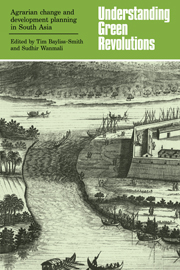Book contents
- Frontmatter
- Contents
- List of contributors
- Preface
- I Understanding Green Revolutions: an overview
- II Agrarian change at village level
- III Development planning and agrarian change
- 12 Rural-based models for rural development: the Indian experience
- 13 Planning and agrarian change in East Africa: appropriate and inappropriate models for land settlement schemes
- 14 Metropolitan expansion in India: spatial dynamics and rural transformation
- 15 Green Revolution and water demand: irrigation and ground water in Sri Lanka and Tamil Nadu
- 16 Social organisation and irrigation: ideology, planning and practice in Sri Lanka's settlement schemes
- 17 Environmental hazard and coastal reclamation: problems and prospects in Bangladesh
- 18 Beyond the Green Revolution: a selective essay
- Index
17 - Environmental hazard and coastal reclamation: problems and prospects in Bangladesh
Published online by Cambridge University Press: 25 May 2010
- Frontmatter
- Contents
- List of contributors
- Preface
- I Understanding Green Revolutions: an overview
- II Agrarian change at village level
- III Development planning and agrarian change
- 12 Rural-based models for rural development: the Indian experience
- 13 Planning and agrarian change in East Africa: appropriate and inappropriate models for land settlement schemes
- 14 Metropolitan expansion in India: spatial dynamics and rural transformation
- 15 Green Revolution and water demand: irrigation and ground water in Sri Lanka and Tamil Nadu
- 16 Social organisation and irrigation: ideology, planning and practice in Sri Lanka's settlement schemes
- 17 Environmental hazard and coastal reclamation: problems and prospects in Bangladesh
- 18 Beyond the Green Revolution: a selective essay
- Index
Summary
The area
Geomorphology
Bangladesh occupies the delta area of the Ganges and Brahmaputra Rivers at the head of the Bay of Bengal (Fig. 17.1). The whole area consists of lowlying deltaic sediments, mainly silts and clays, nowhere higher than 1 m above mean water level. The surface consists of older, raised and dissected deposits inland, with more actively accreting areas to seaward (Morgan & Mclntire, 1959). Over recent centuries the locus of maximum discharge has shifted from west to east. The active tidal delta consists of a maze of tidal channels, chief of which are the rivers Meghna, Shahbazpur and Tetulia. These vary in width from 3 to more than 30 km and are usually less than 5 m deep; they are separated by the large estuarine islands of Bhola, Hatia and Sandwip, with innumerable smaller ephemeral islands and shoals. The land area surrounding these channels comprises the thanas of Barisal, Patuakhali and Noakhali.
The mean annual discharge of the Ganges-Brahmaputra system is 30.9 × 103 cumecs (of which the Brahmaputra contributes 62%), a discharge second only to that of the Amazon among the world's rivers (Meybeck, 1976). Because of the monsoonal rainfall the discharge is highly seasonal, with the extreme high flow being twenty times the low flow in the Ganges and over sixty times in the Brahmaputra. The average suspended sediment load of 2.18 × 109 tons/year (67% delivered by the Ganges) is the largest of any river system in the world (Holeman, 1968).
- Type
- Chapter
- Information
- Understanding Green RevolutionsAgrarian Change and Development Planning in South Asia, pp. 339 - 361Publisher: Cambridge University PressPrint publication year: 1984
- 7
- Cited by



